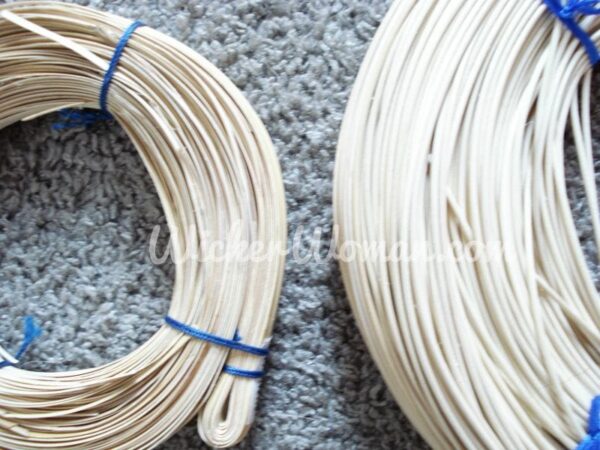
Chair Cane and Rattan Reed, which are both used in weaving chair seats and baskets, come from the rattan palm vine, calamus rotang.
Both are imported here to the United States from Indonesia, Malaysia, the Philippines, and China because they are not indigenous to our country.
This natural vine grows wild along the jungle floor as well as through the trees in the Rain Forest and looks somewhat similar to our grapevine. Lengths can be up to 600 feet with an average diameter of about 2-4 inches.
Processing the Rattan Palm
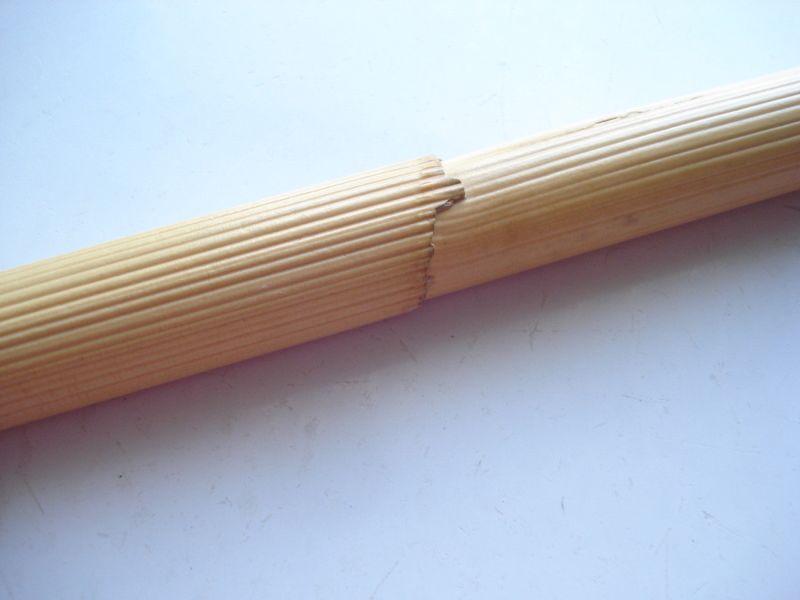
After pulling the vines from the trees and bringing the harvested crop out of the forest, the outer thorns are removed and discarded.
Pulling the vines down and off the trees doesn’t harm the trees. They remain standing and are not cut during this rattan harvest.
The majority of the processing is done in China and Indonesia, so the raw rattan materials are shipped there.
After removing the outer thorns, the outer skin or bark called “cane” is stripped off and machined into strands used for chair caning.
And the inner rattan pith called “reed” is also processed into strips that can later be used in basketry as well as seat weaving projects.
These processed strands and strips of chair cane and rattan reed are wrapped into coils, hanks, and bundles and are ready to go to the exporter.
Wholesale cane & basket suppliers companies purchase these products and then sell to their retail customers, through their brick and mortar stores, hard copy catalogs, or their online website catalogs.
Defining Chair Cane
Cane is a very widely used material and is found in:
- the weaving of chair seats and backs
- for wrapping rattan and stick wicker furniture legs and joints
- basketry projects either as the entire weaving material, an embellishment, or rim wrapping
- room divider panels
- decorative use in cabinetry door panels and radiator covers
- canoe seats
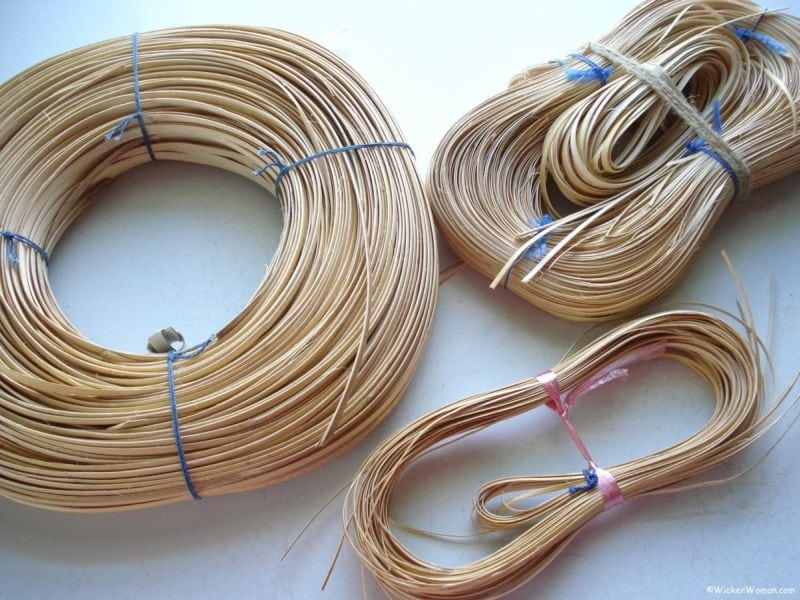
RELATED: Cane Furniture Care and Cleaning
Since cane has a natural glossy finish, it does not accept a stain or paint well and can be difficult to match to an existing set or to “age” its appearance, because of this finish.
It is not necessary to apply any varnish, lacquer, poly or any other final finish material to a cane woven seat, back, or furniture wrapped with it. In fact, it’s best to leave cane furniture in its natural state to age gradually, turning to a nice, amber, honey color after several years.
The cane can also be treated minimally with an oil furniture polish product or an oil-based clear finish like tung oil. Cane can also be rejuvenated somewhat if weathered, by using a mixture of turpentine and boiled linseed oil.
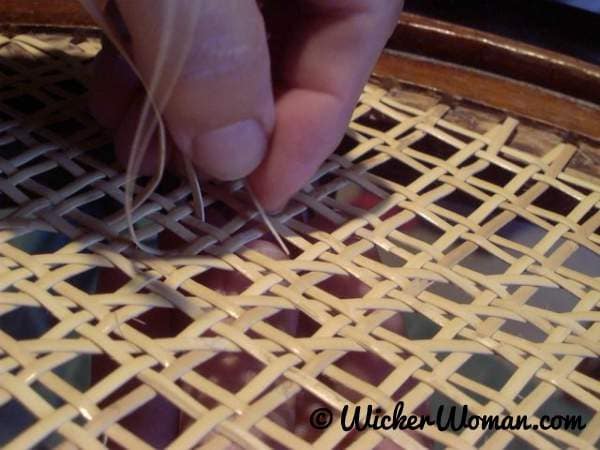
Strand Cane:
The width or gauge of processed cane varies from the smallest super-carriage (1.5 MM), to large slab rattan (8-10 MM), with many sizes in between. The most popular sizes used in chair caning are medium, narrow medium and fine.
The strips or strands of cane are bundled and sold to consumers in either 1,000-foot hanks (enough to weave four chairs), 500-foot hanks (enough to weave two chairs), or 270-foot coils (enough to weave one chair).
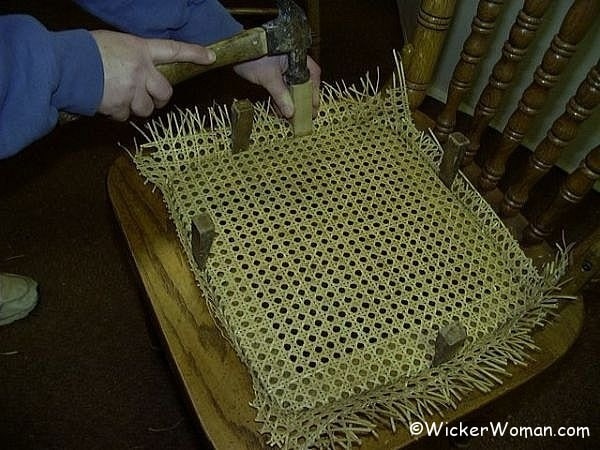
Cane Webbing:
The cane strips can also be woven on a big loom into “sheets” of cane that are used in pressed cane chair seat weaving. These sheets are applied to the chair seat and pressed into a groove around the perimeter of the seat.
Pressed cane, machine woven cane, cane webbing, or sheet cane are some of the names referred to when talking about machine woven cane panels. It comes in a variety of designs and gauges or sizes too.
Cane webbing comes in a variety of designs, which can be seen at all the supplier’s websites; the traditional hole pattern, close-woven pattern, which is solid without any holes, herringbone, Star of David, chevron and others.
RELATED: Cane & Basket Suppliers
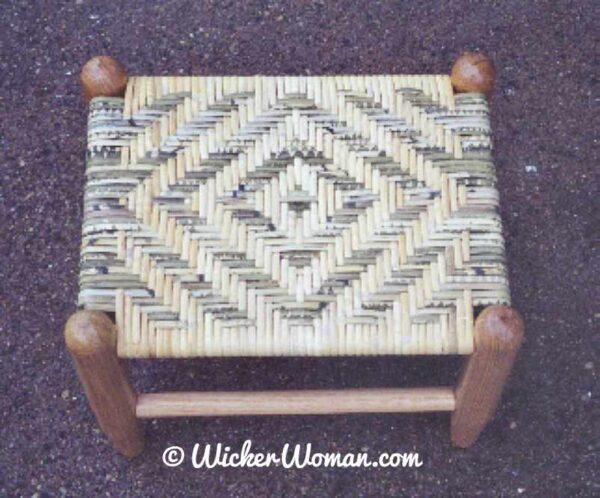
Wide Binding Cane:
Many chair seats with rungs or dowels are woven with the third kind of chair caning in what’s called a “porch cane,” “binders cane,” or “basketweave” pattern technique.
Also, some reproduction furniture is made woven entirely of wide binding cane or slab rattan.
This weaving technique uses wide-binding (4MM-6MM) cane or slab rattan (8MM-10MM), wrapping around the rungs, covering both the top and bottom of the seat.
Since cane has this natural glossy finish and is resistant to moisture, it’s been a popular material choice for use on antique chairs and rockers used on covered or protected porches.
For example, the very popular Plantation or Victorian wooden rockers from the 1880s-1910s used on porches, were frequently woven using wide-binding cane on the seats and backs.
Hence the term “porch cane” furniture is used frequently when speaking about wide-binding seats. Chair caners will often substitute the term “porch cane” or “binders cane” instead of wide-binding cane when referring to the material, too.
Defining Rattan Reed
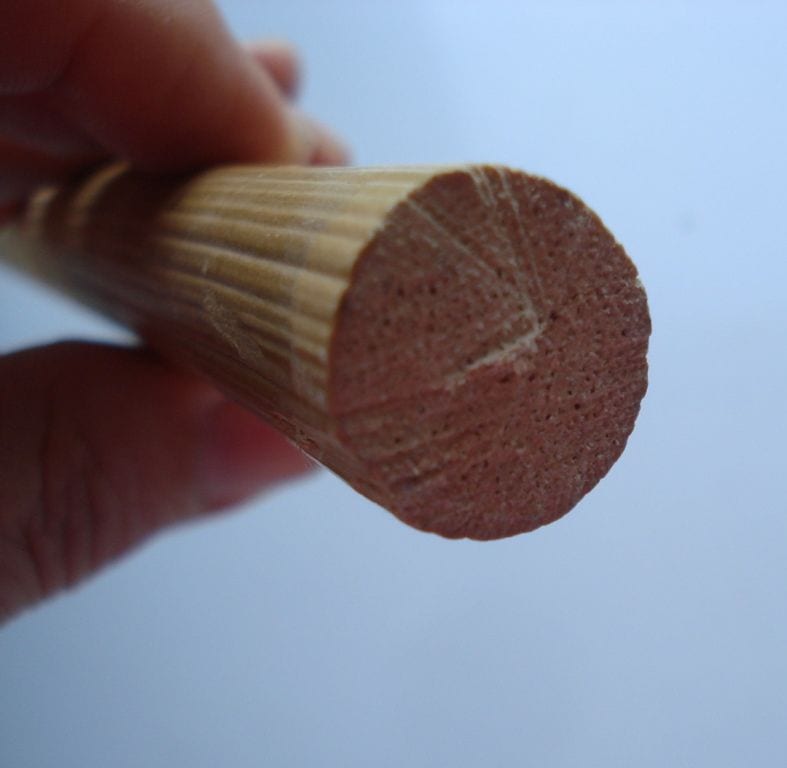
REED, the inner pith or core of the rattan palm, is an extremely versatile material used in weaving wicker furniture and basketry.
Since rattan reed is the inner pith, it does not have the smooth, glossy impenetrable skin of cane. Instead, reed is white in color and has a very porous quality.
This porous reed material does accept paint, stain, varnish, lacquer or poly very well. Whereas cane, with its glossy, finish does not.
RELATED: How to Paint Wicker Furniture Like a Pro!
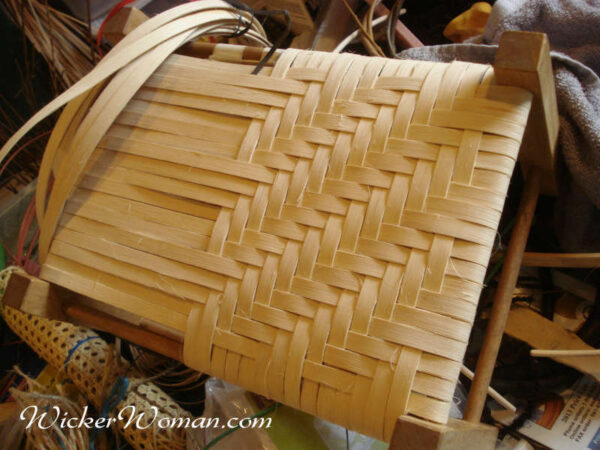
Because of this porous feature, along with its flexibility and the fact that it’s available in a variety of widths and lengths, makes reed a very popular material for any basket weaving or wicker repair project.
Reed is mechanically cut into strips and processed into flat, flat-oval, oval-oval, round and half-round strands. Reed was also available in both the natural tan or bleached white color as well as dyed and even smoked.
Both round and flat reed is generally sold in one-pound coils. Widths of the flat, flat-oval, and oval-oval materials vary from 1″ to 11/64″ with lengths of up to 12 feet or more, sometimes.
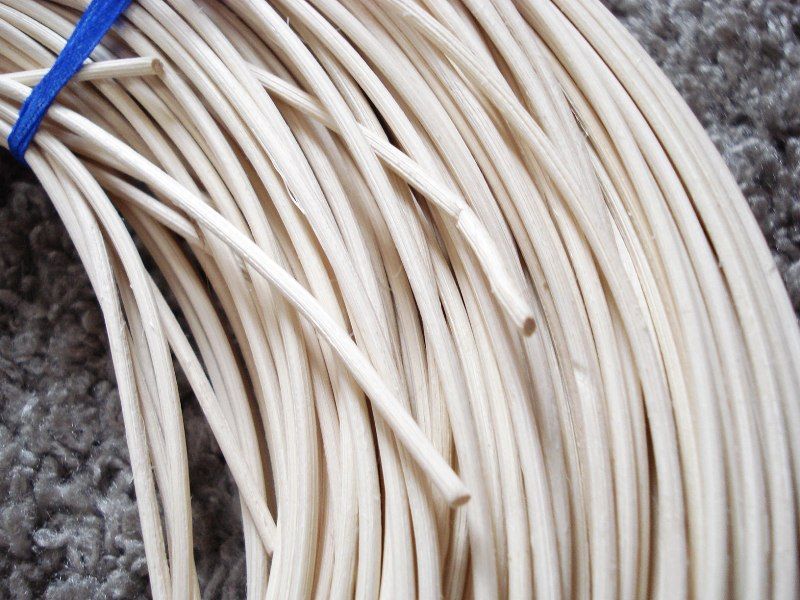
Round reed comes in sizes ranging from the smallest of #00 1/8″ (1.25 MM) to the largest, 5/8″ #18 (16.00MM) and is also available in lengths of over 12 feet.
Because both round and flat reed are so much more versatile than the skin-on rattan poles that were used in the early wicker furniture of the 1840s-1870s, reed quickly became the weaving material of choice for the later Victorian era wicker.
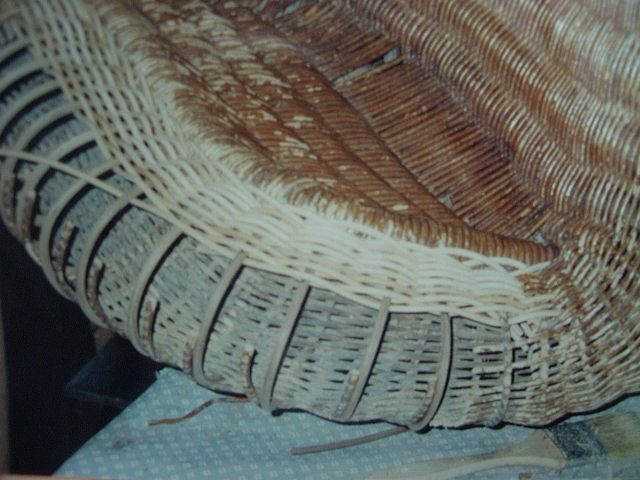
Rattan Reed–Favorite in Antique Wicker Furniture
Rattan reed (the inner pith of rattan), was especially well-suited for the fancy embellishments of the curlicues, loops, braids, and wrappings of the Victorian wicker furniture and baby buggies.
It was highly regarded for its extreme flexibility after soaking in water, could be steam-bent easily and could be so readily stained, painted or lacquered.
RELATED: What are weaving materials used in wicker furniture?
Reed remained the favored choice of weaving materials for wicker furniture long into the 1920s. But in 1904 when the man-made paper fibre rush product was invented, reed took a back seat in consumer popularity.
This new paper product was in stiff competition with the reed manufactured furniture. And later in 1917 after the Lloyd Loom fabric-like sheet wicker was invented, it greatly surpassed rattan reed in popularity amongst the buying public.
Then in about the late 1930s-1940s wicker almost entirely fell out of fashion throughout the country. Everyone was intrigued by the new plastics, teak, and metal furniture of the 50s, 60s, and 70s.
It’s interesting to note that about every 20-25 years, wicker makes a resurgence and is again the “favorite child” among designers and the consumer.
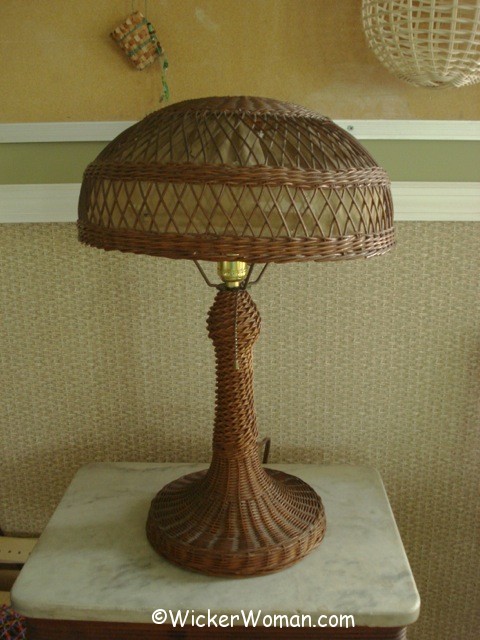
Rattan reed is still used extensively in reproduction and new wicker furniture but is not to be used outdoors and exposed to the elements. If you want to have the romantic look and feel of wicker outdoors, then substitute some of the very fine and well-made resin all-weather wicker furniture that’s currently being manufactured.
RELATED: How to Care for Your Wicker Furniture
Take care of your wicker furniture to preserve, save and protect those old antique and collectible wicker pieces. Only use them indoors and keep them out of the sun and in extra dry locations.
“Once an antique wicker piece is gone, it’s gone forever, you can’t make another antique to use in your lifetime!”
The Wicker Woman–Cathryn Peters
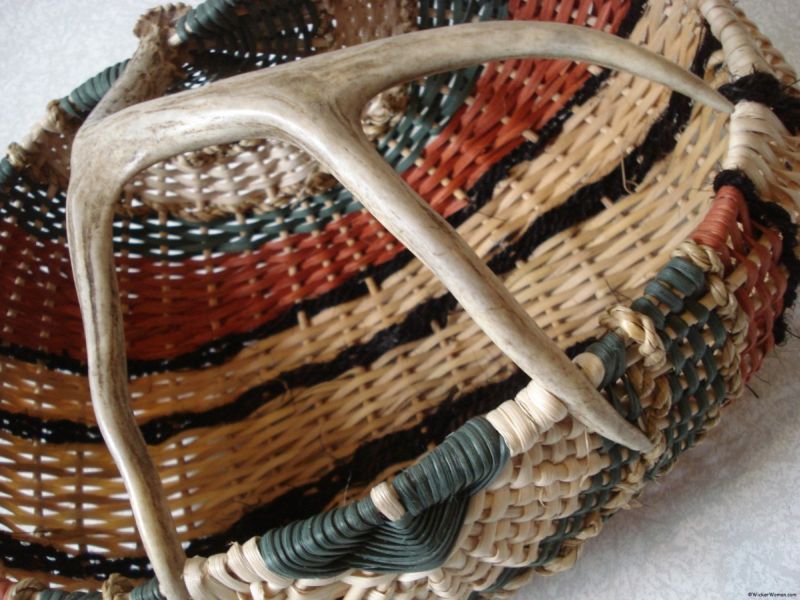
Rattan Reed–1st Choice Material for American Basketweavers
Reed continues to also be the choice of materials for basketweavers here in the United States instead of willow and other natural hand-gathered materials, because:
- reed is a very forgiving and easy-to-use material
- reed is easy to obtain from a retail source
- reed is relatively inexpensive to purchase
- it has a relatively long shelf life
- reed does not need to be prepared prior to use, other than a few minutes soaking in water
- reed is easy to transport to weaving sites
Hope you enjoyed this FREE article on “What are Cane and Reed?” and will help to support this information site by donating generously! Thank you!

Articles, Tip Sheets, Reports <– Back
